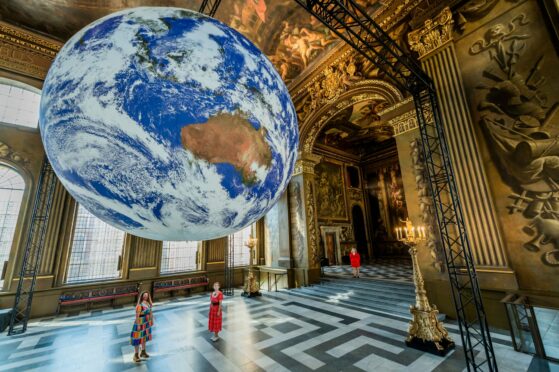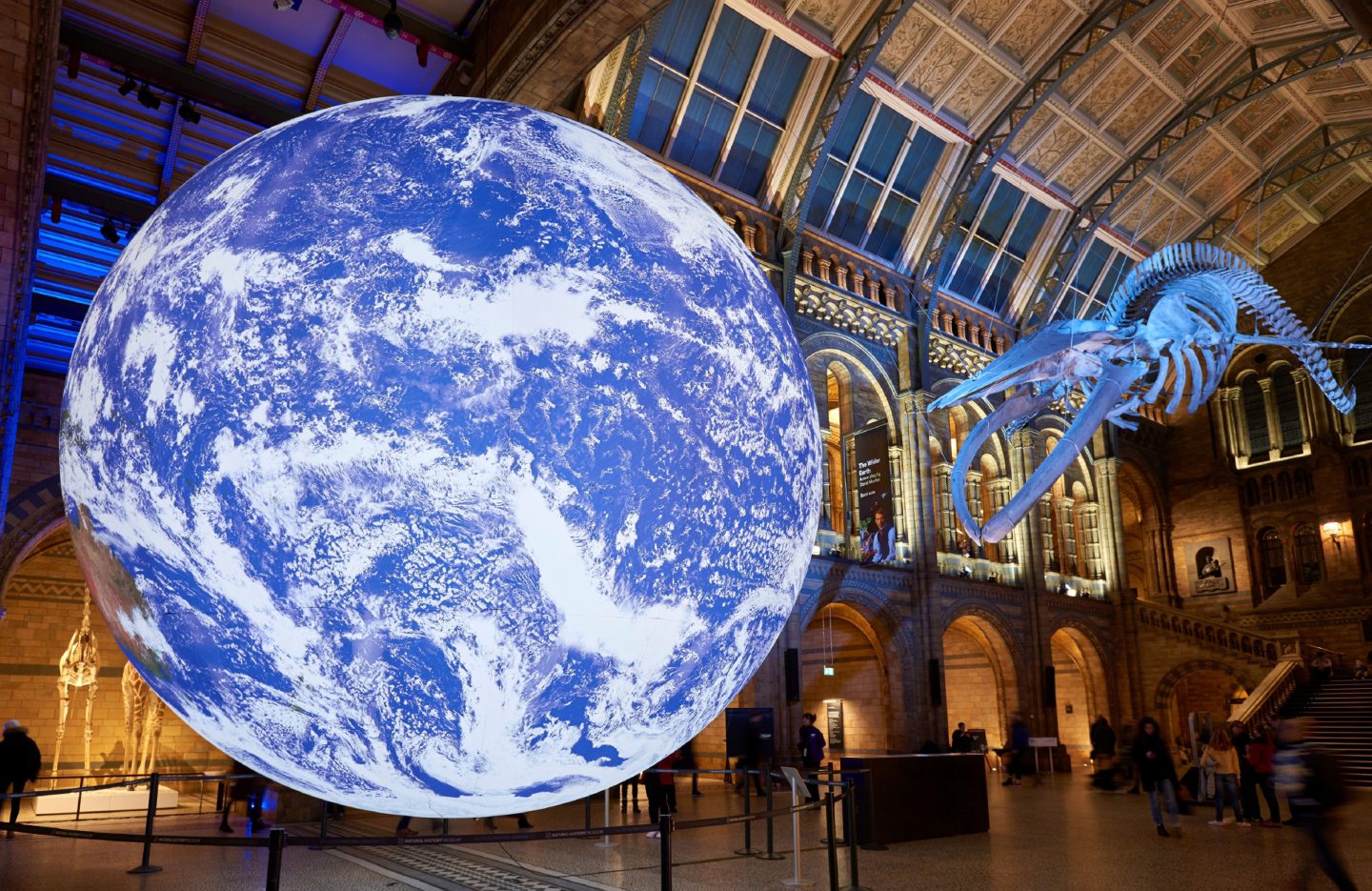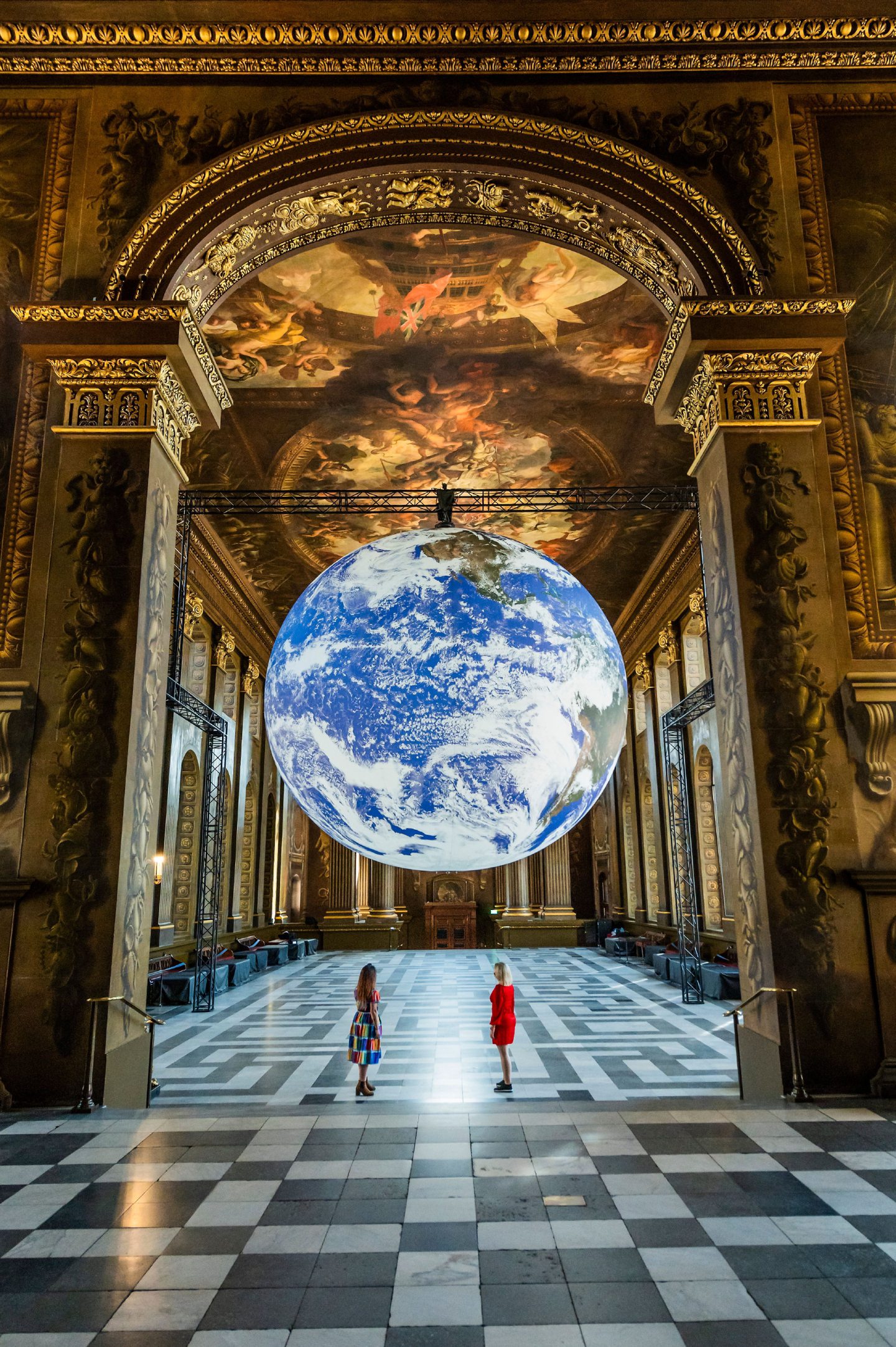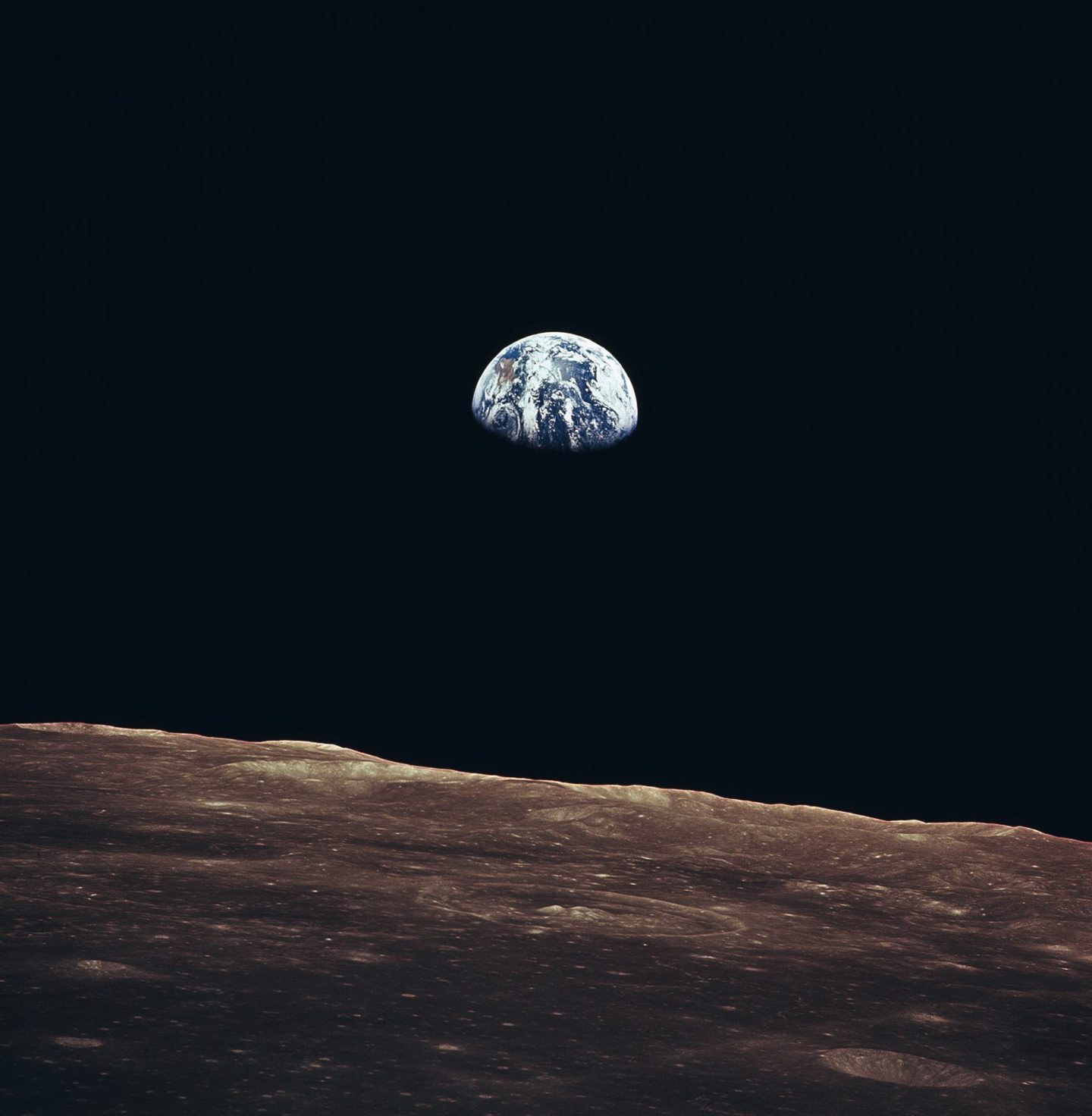
Looking back on his time in space, astronaut Michael Collins once said: “The best crew for the Apollo mission would be a philosopher, a priest and a poet. Unfortunately, they would kill themselves trying to fly the spacecraft. Then you are left with test pilots.”
He had been asked to describe The Overview Effect, a profound cognitive shift as astronauts gaze at the Earth from space for the first time, not only reversing their normal visual perspective, but often transforming their view of humanity and our place in the universe.
Luke Jerram’s art installation Gaia is trying to do what Collins felt he could not, and to find a way to share the experience with the rest of the world.
Measuring seven metres in diameter and created from detailed Nasa imagery of the Earth’s surface, the monumental globe has travelled the world it so beautifully depicts.
Suspended above cities, strung up inside cathedrals, and put on display in front of the world’s most powerful leaders, it returns to Scotland next month, after its star turn at Cop26, for Aberdeen’s Spectra Festival.
Inspired by The Overview Effect, Jerram hopes that, by emulating the same view astronauts have of the planet from outer space, spectators of the work will be inspired to think more deeply about the ecosystem they call home.
Jerram said: “I first came across the concept of The Overview Effect at a conference in the European Space Agency about 15 years ago now.
“There is the sense of the sublime and being overwhelmed by the beauty of something, like looking at The Grand Canyon for the first time and being awed by the enormity of it, or being caught in the middle of a thunderstorm and being surrounded by the drama and wonder of nature. The Overview Effect is very connected to that experience.
“I’ve had people in tears before, where they have been overwhelmed by the beauty of the planet while looking at the Gaia sculpture. They realise it’s our home and we’re on this very fragile, thin sliver of atmosphere – we’re living right on the edge. And so we’re in very vulnerable position. And I think the artwork brings that message home and can be quite moving for people.”
The term The Overview Effect was first coined by writer Frank White in his 1987 book of the same name.
He interviewed astronauts who had seen the Earth from space and documented how such a sight made them feel. Speaking to The Sunday Post, White said: “We’re taught in school that the Earth is part of the solar system, and that it’s a planet.
“We learn all of this intellectually, but what the astronauts say about leaving the planet and looking back is that they experience it as real. It’s real to them now and it’s not just an idea.
“There is a tendency in people who’ve had the experience to be struck by the lack of borders and boundaries when they see the Earth from a distance. Again, we all know that there are no literal lines dividing the planet, but coming to know it from such a direct experience has an impact on them.
“Another aspect of the experience is seeing the thinness of the atmosphere and realising that that’s all we’ve got to protect us from the harshness of outer space. And that tends to create a greater interest in environmental and humanitarian issues.”
White has written extensively about The Overview Effect since the release of the first edition of his book more than 30 years ago, and since then his work has taken on a life of its own, especially in its ability to inspire artists.
Many, like Jerram, hope to recreate The Overview Effect for audiences likely to never leave our planet’s atmosphere and experience the effect for themselves. While White is certain The Overview Effect can never be truly replicated down here on the Earth’s surface, he is heartened by the artistic efforts his work has encouraged.
He said: “I’ve seen a video of people coming out of a cathedral where Gaia was exhibiting and it’s obvious that it had an enormous impact on them. To be clear, you can’t experience the Overview Effect on Earth because it only happens when you are viewing our planet from space. However, a person can have a perspective shift like The Overview Effect through artistic experiences like Gaia. I’m very grateful for that.”
While science and art seem to have little in common on the surface, both are incredibly creative fields. The brightest minds from each discipline have continuously broken new ground throughout history, and brought new ideas to the fore that have had the power to change the world.
The Overview Effect is powerful because it seems to encompass both: the scientific reality of humanity’s predicament with the growing climate crisis, and humanity’s artistic propensity for deep emotional connection with things of extreme beauty and profundity.
On the subject of art and The Overview Effect, White said: “It’s all about exploration, and artists are inherently explorers. That’s the essence of art – to see where your artistic inclinations take you, and if it’s unpredictable, that’s okay.
“That’s really a lot of what space exploration is about as well; you never quite know what you’re going to discover. It seems to me that artists want to make the world a better place through their art, and I think that is what is behind the movement to Bring he Overview Effect down to Earth.
“There is a sense that it’s a positive experience and a positive message. It can improve life on Earth if we can disseminate it.”
With recent commercial space flights seeing celebrities like Jeff Bezos, Richard Branson and Star Trek actor William Shatner blasting off to outer space, White is interested to see if they, too, fall under the sway of The Overview Effect.
He said: “Right now, I am focusing on interviewing the new citizen astronauts. I’m really curious to see how their experience is different than, and similar to, the professional astronauts.
“There’s been a lot of concern about inclusiveness, and we don’t want spaceflight to be only for the wealthy, but initially it probably will be.
“If they are wealthy, and if they have a profound response, they can do something positive with it because they have the means. We don’t know yet what the impact will be.
“There’s a metaphor that we are already on a spaceship: Spaceship Earth.
“There are no passengers, we are all crew members and so we all have to be responsible for the fate of our natural spaceship, which appears to be fragile when seen from a distance.
“I’ve talked to people who say the Earth is not really fragile and that it’s been around for four and a half billion years. It’s really our civilisation that’s fragile. It’s humanity. That’s where the fragility is.”
Luke Jerram’s art installation Gaia will appear at Aberdeen’s Spectra festival, February 10-13
The Blue Marble
The men and women who have travelled out of Earth’s atmosphere reflect on The Overview Effect, the awe-inspiring sight of our planet from outer space.
The Earth was small, light blue, and so touchingly alone, our home that must be defended like a holy relic. The Earth was absolutely round. I believe I never knew what the word round meant until I saw Earth from space.
Aleksei Leonov, the first human to walk in space in 1965
As we got further and further away, it diminished in size. Finally it shrank to the size of a marble, the most beautiful you can imagine. That beautiful, warm, living object looked so fragile, so delicate, that if you touched it with a finger it would crumble and fall apart. Seeing this has to change a man.
James B Irwin, who went to the moon in 1971
There was a startling recognition that the nature of the universe was not as I had been taught. I not only saw the connectedness, I felt it. I was overwhelmed with the sensation of physically and mentally extending out into the cosmos.
I realised that this was a biological response of my brain attempting to reorganise and give meaning to information about the wonderful and awesome processes that I was privileged to view.
Edgar Mitchell, sixth man on the moon
I think you start out with this idea of what it’s going to be like. And then when you do finally look at the Earth for the first time, you are overwhelmed by how much more beautiful it really is when you see it for real.
It’s just this dynamic, alive place that you see glowing all the time. Awe is one of those words that you have a better understanding of when you see it too. I felt like using the word awesome was totally appropriate when it came to describing what the planet looks like.
Nicole Stott, who walked in space at the International Space Station in 2009
It suddenly struck me that that tiny pea, pretty and blue, was the Earth. I put up my thumb and shut one eye, and my thumb blotted out the planet Earth. I didn’t feel like a giant. I felt very, very small.
Neil Armstrong, the first human to walk on the moon in 1969
I can only describe what I have seen. Looking down at the Earth and you see that line that separates day into night slowly moving across the planet. Thunderstorms on the horizon casting these long shadows as the sun sets.
And then watching the world come alive, and you see the lights from the cities and the towns. Shooting stars going below us or dancing curtains of auroras, it is very hard to describe all the colours, the beauty, the motion.
Anybody else who has ever gone to space says the same thing, because it really is striking, and it is really sobering to see this paper-thin layer, and to realise that that little paper-thin layer is all that protects every living thing on Earth from death, basically. From the harshness of space.
Ron Garan, who had two stints at the International Space Station, the last in 2011
Everybody in the world needs to do this. Everybody in the world needs to see. It was unbelievable.
Unbelievable. I mean, the little things, the weightlessness. But to see the blue colour go whip by, and now you’re staring into blackness. That’s the thing.
The covering of blue is this sheet, this blanket, this comforter of blue that we have around. We think: “Oh, that’s just blue sky.”
And there’s something you shoot through, and all of a sudden, as though you whip a sheet off you when you’re asleep, and you’re looking into blackness, into black ugliness.
And you look down. There’s the blue down there and the black up there. And there is mother Earth and comfort. And up there, is that death? I don’t know.
Actor William Shatner, who, at 90, became the oldest man in space on October 13, 2021

Enjoy the convenience of having The Sunday Post delivered as a digital ePaper straight to your smartphone, tablet or computer.
Subscribe for only £5.49 a month and enjoy all the benefits of the printed paper as a digital replica.
Subscribe © PA
© PA © Guy Bell/Shutterstock
© Guy Bell/Shutterstock © Nasa/UPI/Shutterstock
© Nasa/UPI/Shutterstock